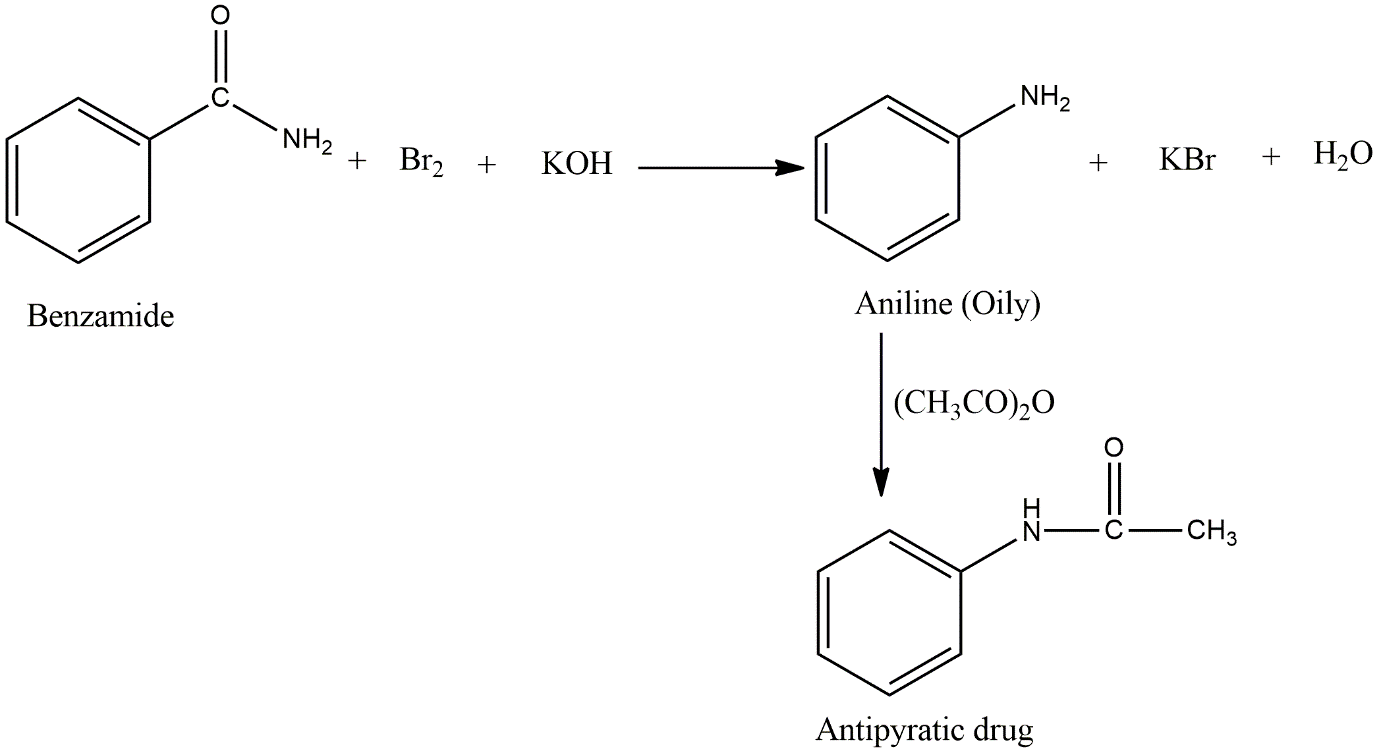
A nitrogen-containing organic compound gave an oily liquid on heating with bromine and potassium hydroxide solution. On shaking the product with acetic anhydride, an antipyretic drug was obtained. The reactions indicate that the starting compound is:
A. Aniline
B. Benzamide
C. Acetamide
D. Nitrobenzene
Answer
225k+ views
Hint: All the options are nitrogen-containing organic compounds. Aniline, benzamide, acetamide, and nitrobenzene have amine, amide, amide, and nitro functional groups respectively.
Complete Step by Step Solution:
On heating with bromine and potassium hydroxide, the Hoffmann bromamide reaction takes place. In this reaction, primary amide gets degraded and forms primary amine. So first, find the compounds with amide functional groups from the given options.
Here, in the options, the first options B and C contain an amide functional group. In the question, it is mentioned that an oily compound is formed meaning it is non-volatile and aromatic compounds are non-volatile. Of the B and C options, only the B option i.e., benzamide is aromatic. And also, acetamide is solid, not an oily compound. So, the starting compound is benzamide.

Image:Hofmann bromamide reaction of benzamide and formation of antipyretic drug.
In this reaction product without a carbonyl functional group and hence benzamide forms aniline which is aromatic in nature and oily. Aniline then further reacted with acetic anhydride to give acetanilide which is an antipyretic drug.
So, the option B is correct.
Note: Antipyretic drugs are used in fever. Some examples are acetanilide, ibuprofen, and acetaminophen. Physical properties of compounds are equally important to understanding the chemistry of reactions. Here, aromatic compounds are non-volatile compounds because of the conjugation present in the system making the system stable.
Complete Step by Step Solution:
On heating with bromine and potassium hydroxide, the Hoffmann bromamide reaction takes place. In this reaction, primary amide gets degraded and forms primary amine. So first, find the compounds with amide functional groups from the given options.
Here, in the options, the first options B and C contain an amide functional group. In the question, it is mentioned that an oily compound is formed meaning it is non-volatile and aromatic compounds are non-volatile. Of the B and C options, only the B option i.e., benzamide is aromatic. And also, acetamide is solid, not an oily compound. So, the starting compound is benzamide.

Image:Hofmann bromamide reaction of benzamide and formation of antipyretic drug.
In this reaction product without a carbonyl functional group and hence benzamide forms aniline which is aromatic in nature and oily. Aniline then further reacted with acetic anhydride to give acetanilide which is an antipyretic drug.
So, the option B is correct.
Note: Antipyretic drugs are used in fever. Some examples are acetanilide, ibuprofen, and acetaminophen. Physical properties of compounds are equally important to understanding the chemistry of reactions. Here, aromatic compounds are non-volatile compounds because of the conjugation present in the system making the system stable.
Recently Updated Pages
JEE Main 2025-26 Mock Test: Organic Compounds Containing Nitrogen

JEE Main 2025-26 Organic Compounds Containing Nitrogen Mock Test

JEE Main Chemical Kinetics Mock Test 2025-26: Free Practice Online

JEE Main 2025-26 Organic Compounds Containing Oxygen Mock Test

JEE Main 2025-26 Organic Compounds Containing Halogens Mock Test

Sodium acetate on heating with soda lime produce A class 12 chemistry JEE_Main

Trending doubts
JEE Main 2026: City Intimation Slip and Exam Dates Released, Application Form Closed, Syllabus & Eligibility

JEE Main 2026 Application Login: Direct Link, Registration, Form Fill, and Steps

Understanding the Angle of Deviation in a Prism

How to Convert a Galvanometer into an Ammeter or Voltmeter

Hybridisation in Chemistry – Concept, Types & Applications

Ideal and Non-Ideal Solutions Explained for Class 12 Chemistry

Other Pages
NCERT Solutions For Class 12 Chemistry Chapter 1 Solutions - 2025-26

JEE Advanced Marks vs Ranks 2025: Understanding Category-wise Qualifying Marks and Previous Year Cut-offs

Solutions Class 12 Chemistry Chapter 1 CBSE Notes - 2025-26

NCERT Solutions ForClass 12 Chemistry Chapter Chapter 4 The D and F Block Elements

Biomolecules Class 12 Chemistry Chapter 10 CBSE Notes - 2025-26

NCERT Solutions For Class 12 Chemistry Chapter 10 Biomolecules - 2025-26




